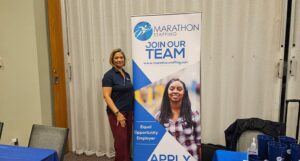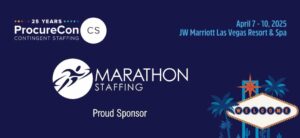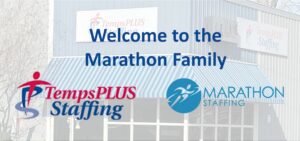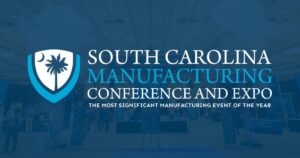News & Events

Marathon at Work at Jefferson County’s DHR Annual Job Fair
The Marathon Birmingham team recently participated in Jefferson County’s Department of Human Resources Annual Job Fair on June 17 in partnership with the University of Alabama at Birmingham (UAB) Trio Educational Opportunity Center.
We joined other Birmingham employers and training organizations in this opportunity to meet job seekers interested in fields that included healthcare, construction, hospitality, and more. As a participating vendor, Marathon contributed towards hourly name drawings and other fun activities that took place throughout the day.
“It’s always a pleasure to give back to our community in such a meaningful way,” Linda Patterson from the Marathon Birmingham office reflected on the event. Linda has also been an active member of the DHR Advisory Board since 2010.
Marathon is a long-standing collaborator of Jefferson County, participating regularly in this annual event. We are happy to have been able to assist over 65 individuals on their professional journeys so far from the interactions our representatives, Linda and Nancy Morris, had during the job fair.
We appreciate the opportunity to join Jefferson County’s DHR and UAB’s Trio Educational Opportunity Center and look forward to future opportunities to continue to contribute to our local community!
Written by:
Naomi Raices
Marketing Coordinator
nraices@marathonstaffing.com

Giving Back to the Community: Marathon and Habitat for Humanity
Marathon is happy to have been part of a day of volunteering alongside Habitat for Humanity in Canton, OH. Volunteers helped ensure that local playground and park areas were ready for families in the community to enjoy during the upcoming warmer months.
The work was also in preparation of Summer Kickoff, hosted by Habitat for Humanity’s East Central Ohio group and other local organizations.
Shawna Miranda and Roslyn Brown, members of the Marathon team, assisted with the clean-up of several outdoor spaces. Shawna loved being involved in this opportunity, “dedicating my time to give back to my community, it makes me feel productive.”
Roslyn also expressed the enjoyment of being able to help, “[j]ust to see people smile and have a great day is always, always, always a Joy for Me!!!”
At Marathon, community is very important and it’s central to the work we do. We are grateful to have been able to connect with other individuals and organizations and to have been part of such impactful work.
Thank you to Habitat for Humanity for having us. We look forward to contributing to other community projects like these in the future!
Written by:
Naomi Raices
Marketing Coordinator
nraices@marathonstaffing.com

Marathon is Excited to Sponsor ProcureCon Contingent Staffing in Las Vegas
We are thrilled to join top leaders in the areas of procurement and sourcing at this year’s ProcureCon Contingent Staffing taking place at the JW Marriott Las Vegas Resort & Spa in Las Vegas, NV from April 7th through the 10th.
As an Event Sponsor, we hope to connect with other attendees and hear about current trends and topics. We look forward to celebrating 25 years of ProcureCon Contingent Staffing alongside everyone!
With over 37 years of experience in staffing and talent sourcing spaces, Marathon has helped businesses build strong, high-performing teams with customized staffing solutions, including temporary, contract, and direct-hire talent.
If you’re participating in this event, be sure to get in touch with us at 414-526-6707 and say hello to Luis Reyes, Division Manager.
Our team will be happy to discuss Marathon’s services in more detail and how we might best assist your organization’s needs. Whether you’re looking to address specific challenges, improve operational efficiency, or discover new solutions tailored to your needs, our team is ready to share insights and work with you!
Written by:
Naomi Raices
Marketing Coordinator
nraices@marathonstaffing.com

Marathon Staffing Welcomes Temps Plus Staffing into the Family
Effective January 13, 2025, Marathon Staffing is thrilled to announce the acquisition of Temps Plus Staffing (TPS), a respected staffing agency with offices in Blytheville, Arkansas, and Osceola, Arkansas. This strategic integration marks an exciting milestone for Marathon Staffing as we continue to expand our reach and capabilities, bringing exceptional staffing solutions to even more businesses and communities.
Through this partnership, Marathon Staffing is broadening its geographic footprint while deepening our expertise in serving light industrial and municipal clients. TPS has a rich history of delivering outstanding service in Northeastern Arkansas, and we are honored to build upon the strong relationships they have cultivated in Mississippi County and beyond.
A Warm Welcome to Peggy Lemons and the TPS Team
We are delighted to welcome Peggy Lemons, the owner and operator of TPS for over 30 years, to the Marathon family. Peggy’s leadership and vision have been instrumental in making TPS a trusted partner for businesses in the region. As Marathon’s new Director of Regional Business Development, Peggy will play a pivotal role in driving growth and strengthening client relationships across Northeastern Arkansas.
Joining Peggy are her exceptional team members, including experienced recruitment coordinators, a skilled payroll coordinator, and a dedicated area manager. Together, their expertise and local knowledge will enhance Marathon’s ability to deliver tailored staffing solutions that meet the unique needs of the Arkansas community.
Building on Arkansas’s Workforce Momentum
Arkansas is a state experiencing remarkable workforce growth and opportunity, and we are excited to contribute to this dynamic environment. By integrating TPS into Marathon Staffing, we are not only expanding our operational presence but also reinforcing our commitment to fostering strong connections with businesses and job seekers in the region.
At Marathon, we understand that local partnerships are the cornerstone of success, and we are eager to collaborate with businesses in Mississippi County and beyond to address their staffing needs. Whether it’s supporting light industrial operations, municipal projects, or other workforce initiatives, Marathon is ready to bring our proven expertise and resources to the table.
Looking Ahead
As we embark on this new chapter, we are filled with enthusiasm for the future. The integration of TPS into Marathon Staffing represents a shared commitment to excellence, innovation, and community partnership. Together, we will continue to deliver the high-quality staffing services that businesses rely on while creating meaningful opportunities for workers across Northeastern Arkansas.
We extend our heartfelt gratitude to Peggy Lemons and her team for their dedication and leadership. We are proud to have them as part of the Marathon family and look forward to achieving great things together. Here’s to a bright future for Marathon Staffing, TPS, and the communities we serve!
Written by:
Kendra Strickland
Chief Operating Officer
kstrickland@marathonstaffing.com

Join Marathon at the 2024 SC Manufacturing Conference and Expo in Greenville, SC!
Marathon Staffing (Booth #215) looks forward to seeing you at this year’s South Carolina Manufacturing Conference and Expo, in Greenville, SC from November 7th to 8th at the Greenville Convention Center!
Score Big Talent – Stop by our booth for a chance to earn prizes and giveaways, and to learn more about how we can be an MVP in finding you great talent!
With over 2,000+ attendees, the conference serves as a hub for new discussions regarding current trends and topics in manufacturing culture. Look for us at the Registration Area and at Booth #215.
Marathon has been serving SC Manufacturers since 2004 and we are thrilled to be participating as a Conference Sponsor this year. We look forward to taking part in conversations with fellow industry players as we contribute to the progression of the industry in South Carolina. We hope to see you there!
Written by:
Naomi Raices
Marketing Coordinator
nraices@marathonstaffing.com

Women in Manufacturing Summit: Unmasking Hiring Nightmares with Marathon Staffing
Calling all Women in Manufacturing leaders! Join Marathon Staffing at the WIM Summit 2024 in Boston (Oct. 6-9) at the Hynes Convention Center and discover how to conquer your scariest hiring challenges.
Unveiling Spooktacular Solutions:
- Booth #406: Visit us for insights on building a strong talent pipeline.
- WIMX Stage: Don’t miss Marathon’s Head of Innovation, Christopher Panagiotopoulos, on Tuesday, Oct 8th. Chris will be sharing “3 Spooktacular Tales of Hiring Horror and How to Prevent Them.” Learn valuable tips to avoid common pitfalls and build a successful hiring strategy.
Beyond the Expo:
Treat yourself to a unique experience! Pre-register for our exclusive Boston Ghost Tour following the Expo hours on Oct 8th (link: https://lnkd.in/eaYMKRrV). Network with fellow attendees and create lasting connections in a fun, spooky atmosphere.
Written by:
Kendra Strickland
Chief Operating Officer
kstrickland@marathonstaffing.com